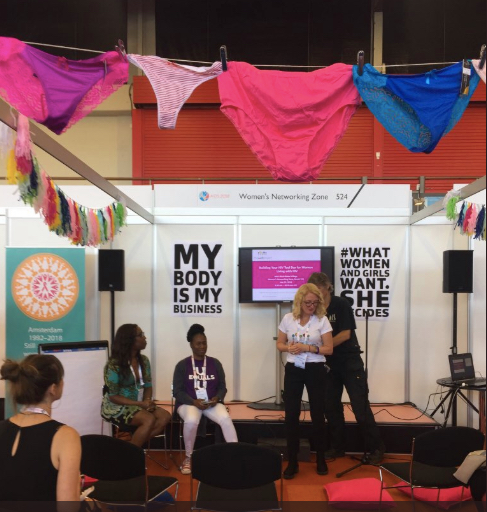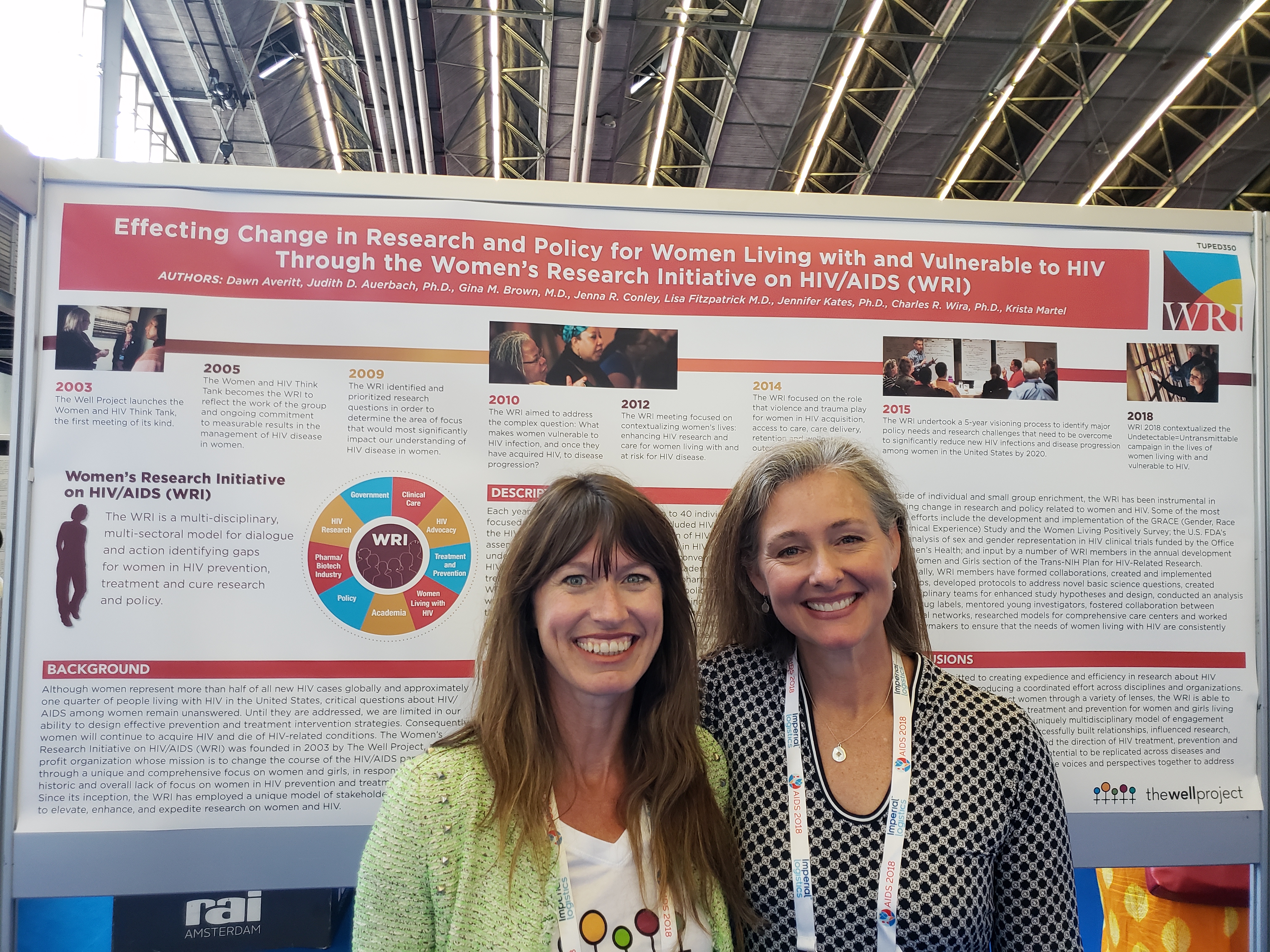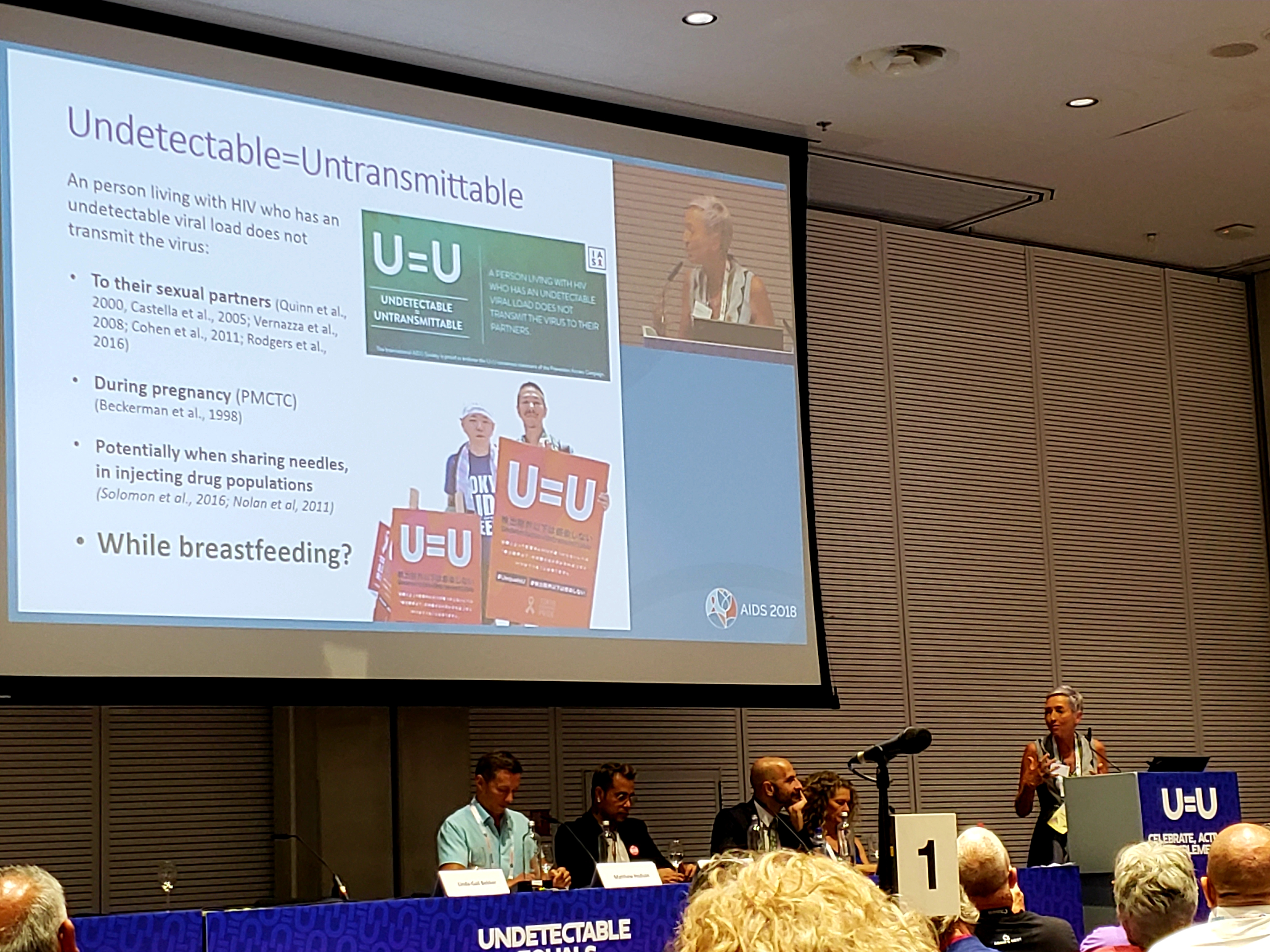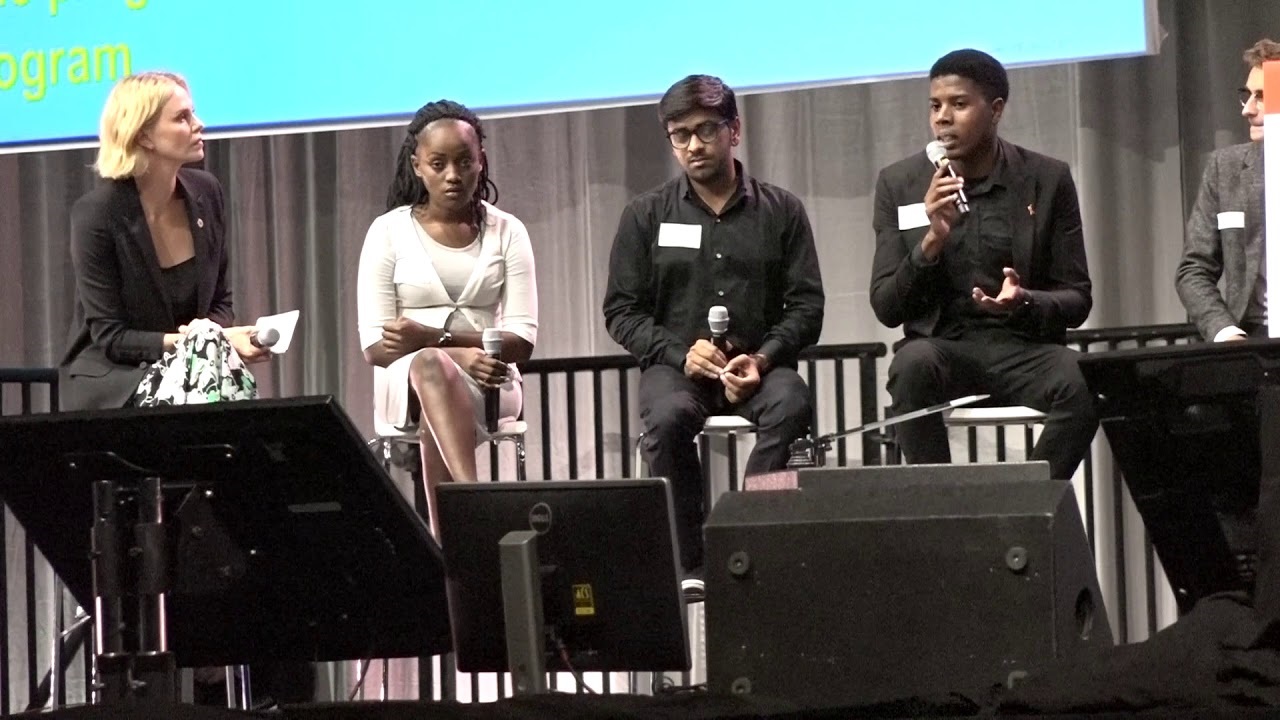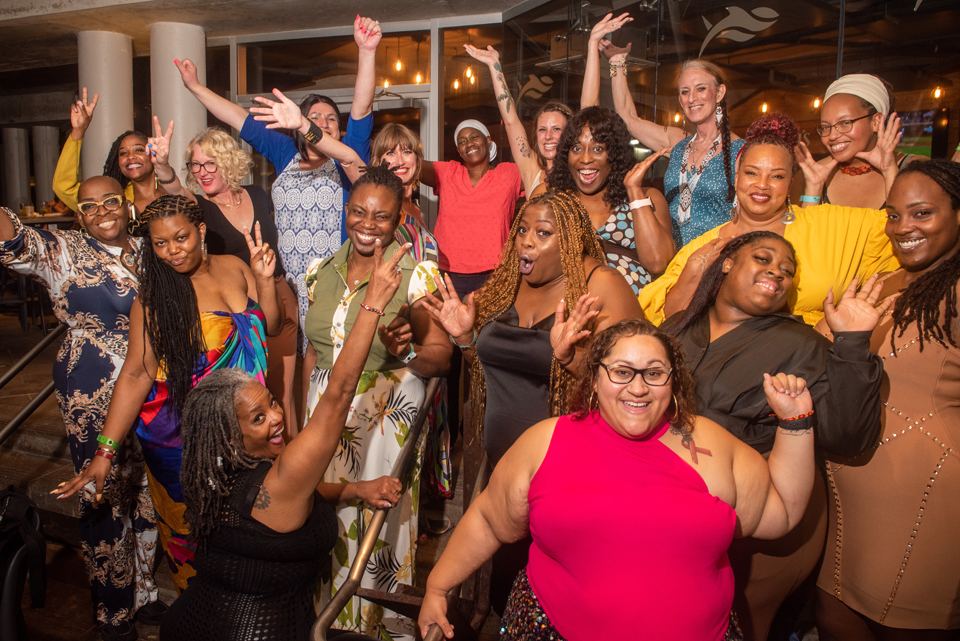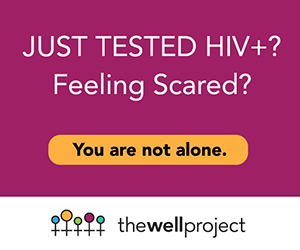by Krista Martel, Jenna Conley, Dawn Averitt, and Sarah Denison-Johnston
The Well Project was thrilled to have a strong presence at the 22nd International AIDS Conference in Amsterdam July 23-27, 2018. This bi-annual conference attracted 17,000 attendees from all over the world and featured the latest in HIV science, research, and advocacy. The Well Project had several presentations:
- Building an 'HIV Toolbox' for Women Living with HIV: The Well Project presented an interactive session on how to create an HIV toolbox to build leadership and community, using our free online resources at the Women's Networking Zone in the Global Village on Monday, July 23. Speakers included executive director, Krista Martel; community advisory board (CAB) and Women's Research Initiative on HIV/AIDS (WRI) member Gina Brown, MSW; and CAB member and communications coordinator, Tiommi Luckett.
- Effecting Change in Research and Policy for Women Living with and Vulnerable to HIV through the Women's Research Initiative on HIV/AIDS: Members of the WRI presented this poster, which describes the WRI as a multi-sectoral model of engagement and action, on Tuesday, July 24.
WRI Program Director, Jenna Conley, and WRI Founding Director, Dawn Averritt
- Contextualizing U=U in the Lives of Women Living with and Vulnerable to HIV: The Well Project hosted a panel discussion on considerations related to U=U for women in the U=U Networking Zone in the Global Village on Tuesday, July 24. Speakers included executive director, Krista Martel; co-chair of the board and WRI advisory board member Judith D. Auerbach, Ph.D.; founder and founding director of the WRI, Dawn Averitt; CAB member and WRI member, Gina Brown, MSW; and CAB member and communications coordinator, Tiommi Luckett. Click here to see a video from the panel discussion!
We've compiled a number of highlights from the conference that we think our readers will be particularly interested in, so please read on for more information! We also invite you to check out some videos from AIDS 2018 on our YouTube channel, as well as visit our AIDS 2018 Facebook album of photos!
U=U at AIDS 2018
As a continuation of The Well Project's proud support for Undetectable = Untransmittable (U=U), we were honored to be a sponsor of the U=U pre-conference at AIDS 2018. This remarkable event featured a variety of presentations and panels, including a keynote presentation by Dr. Anthony Fauci, Director of the National Institute of Allergy and Infectious Diseases (NIAID), sessions that investigated the state of U=U around the world, U=U messaging to fight stigma, U=U and advocacy campaigns, and putting U=U into practice. The pre-conference also facilitated an important conversation between researchers and community members about the state of U=U evidence on transmission risks related to breastfeeding and injection drug use, as well as perceptions and understanding of the facts behind U=U.
The U=U pre-conference presented a Lifetime Achievement in Health and Human Rights Award to Dr. Pietro Vernazza, the author of the Swiss Statement, one of the first pieces of scientific evidence to show that undetectable equals untransmittable. Several community members presented him with the award, including The Well Project CAB and WRI member Gina Brown, MSW. Click here to check it out!
Charles King wrapped up the pre-conference with an inspiring closing speech that recapped quotes heard throughout the day – please take a look here!
Important research presented at AIDS 2018 also further supported and validated the science of U=U. Final data from the PARTNER study showed that there is zero chance that anyone living with HIV who has a suppressed viral load sexually transmitting the virus to a partner. Results from the first phase of the study (PARTNER 1) already indicated that U=U in heterosexual couples, but the second phase, PARTNER 2, confirmed that U=U also applies to gay men.
There continue to be many questions about breastfeeding and whether U=U applies to this potential mode of transmission. At AIDS 2018, a variety of presentations made clear that there is insufficient evidence for U = U in breastfeeding. There are many issues that impact a woman's decision about breastfeeding, and The Well Project is in the process of developing a fact sheet that addresses these nuances and the need for an informed choice. Stay tuned for more information!
Updates on the Use of Dolutegravir in Pregnant Women
Thousands of scientists, doctors, advocates, and policymakers packed an auditorium at AIDS 2018 to hear a panel discussion on the safety of dolutegravir in pregnant women. In May 2018, the World Health Organization identified four babies who were born with neural tube defects after being exposed to dolutegravir. Researchers conducted a follow-up study in which they were unable to identify other potential causes of these defects, suggesting (but not confirming) that dolutegravir use in women during or before conception may increase the chance of neural tube defects.
It is important to know that when compared to efavirenz-based treatments, dolutegravir has otherwise proven to be more effective at viral suppression, has fewer side effects and less drug resistance, and is drastically more affordable. While researchers were unable to draw concrete conclusions about the relationship between the defects and doluletgravir use, many countries began barring the use of dolutegravir among women between the ages of 14-49. In some areas, women were only permitted to receive the new treatment when they agreed to sterilization. Understandably, women living with HIV responded to these new barriers angrily and vocally. A community representative on the panel reminded those in attendance, "if women are given ample freedom of choice and access to information, they will make the right decision."
Caitlin Dugdale, from the Medical Practice Evaluation Center in Massachusetts, shared her findings from a model-based comparison of efavirenz and dolutegravir, emphasizing that the cost-benefit analysis is more complicated than infant mortality rates. Her analysis compared the two drugs in terms of their theoretical large-scale impact on sexual transmissions, pediatric infections, suppressive efficacy, fertility rates, mother mortality rate, and the risk of neural tube defects. She concluded that each drug had its benefits and drawbacks, with efavirenz causing fewer neural tube defects and dolutegravir saving three times the number of women than efavirenz saved babies. She added that, at the end of the day, a more nuanced approach based on individual considerations with respect to drug choice would likely lead to the best outcomes.
Experts Publish Consensus On Science Of HIV And Criminalization
A very important development at AIDS 2018 was the announcement of the "Expert Consensus Statement on the Science of HIV in the Context of Criminal Law," a document that aims at "reducing stigma and discrimination and avoiding miscarriages of justice."
Twenty of the world's leading HIV researchers came together to warn about the societal dangers of prosecuting people living with HIV and encourage the judicial system to take into account the current science around transmission risk when applying these criminalization laws. "Simply put, HIV criminalization laws are ineffective, unwarranted and discriminatory," Expert Consensus Statement co-author and IAS President Linda-Gail Bekker said. "In many cases, these misconceived laws exacerbate the spread of HIV by driving people living with and at risk of infection into hiding and away from treatment services."
The statement stresses that:
- There is no possibility of HIV transmission via contact with the saliva of an HIV-positive person, including through kissing, biting or spitting.
- The risk of transmission from a single act of unprotected sex is very low, and there is no possibility of HIV transmission during vaginal or anal sex when the HIV-positive partner has an undetectable viral load.
- It is not possible to establish proof of HIV transmission from one individual to another, even with the most advanced scientific tools.
While the consensus statement is an important tool to help PLHIV facing criminal charges, it is also important to note that criminal law reform efforts spread the false idea that, without HIV drugs and an undetectable viral load, legal punishment of people living with HIV is acceptable. Criminalizing people based on HIV status is harmful to public health and is never appropriate, no matter what the person's viral load. Click here to read and endorse the Consensus Statement on HIV "Treatment as Prevention" in Criminal Law Reform, which advocates the most "pressing responsibility in HIV criminal law reform is to challenge these two problems by advocating for the related core legal principles that (1) convictions must require proof that the person intended to do harm; and (2) the degree of punishment must be closely related to the level of injury."
The Role of Youth in the Fight Against HIV/AIDS
Nothing for us without us: #PassTheMic was a panel discussion by youth leaders that was moderated by Charlize Theron. It began by exploring the idea of meaningful youth participation. Brian from Uganda focused on accessibility, pointing out that many clinics were only open during school hours, making regular trips to the clinic impossible for serious students. Zakk, from Los Angeles, CA, emphasized the need for both youth advisors and youth decision makers, saying that youth need to have the power to reject or change programs intended for them which don't work.
When it came to improving programming for youth, one theme kept resurfacing: the need for psychosocial support. Chinmay from India spoke passionately about the various psychological problems that can arise from loss, isolation, and stigma, and the failure of his local clinics to address these issues in youth. Josephine, from Uganda, testified that psychosocial support was the key to her success. She also spoke of pill fatigue and the need for psychosocial support to give hope to youth, which in turn could achieve better adherence rates. Peter, a young man from Malawi, highlighted the importance of peer-based support services that foster trust and freedom from the kind of judgment youth may experience from older, more traditional figures. Melodi, from Amsterdam, stressed the value of integrated treatment services that address a variety of intersecting issues and needs beyond HIV. "It's not just about HIV," Zakk said. "It's about our lives".
Despite the many concerns raised, the session was also hopeful. The panel demonstrated their passion and willingness to fight. "When the system fails us, youth step up!" said Melodi, "So come and join us."
DREAMS update
At "Daring to DREAM", a session summarizing the results of PEPFAR's recent programming focused on adolescent girls and young women, Ambassador Deborah Birx pointed out that the most effective HIV/AIDS interventions are multi-lateral and intersectional. After all, HIV is affected by so many things, including inequality, sexual orientation, gender, race, age, nationality, profession, health, or socio-economic status. DREAMS, a PEPFAR public-private partnership, uses a variety of local tactics and infrastructures to focus on adolescent girls and young women as whole human beings. DREAMS works both to improve access to life-saving drugs and to achieve a better standard of living for adolescent girls and young women. That better living standard would minimize HIV-related risks such as poverty, drug use, and sexual abuse.
DREAMS programs have a variety of limitations and challenges. The partnership runs programs in 15 countries, all of which have local issues, and each of which experiences varying degrees of success. Some programs, such as those in Mozambique, are very successful, with a more than 25% drop in new infections, while others are slower to see progress. Establishing the infrastructure with which these multi-lateral organizations can collaborate is an enormous challenge. Many of these interventions also fight to empower young women, and are at times in conflict with local traditional communities.
Still, after just 13.5 months of preliminary implementation and observational research, Ambassador Birx says that DREAMS is off to a great start. One of the grantees spoke about the program with great excitement and hope: "The broken generation ends here!"
Aging with HIV
With an ever-increasing number of people living with HIV who will be over fifty in the next 5-10 years, it may come as a shock to learn that there is comparatively little research on aging and HIV. There are clear reasons why this has been true in the past: older adults were historically not included in research because there were not as many older people living with HIV to study and people were not expected to live long enough to get old. Thankfully, this is no longer the case thanks to the success of newer treatments.
Today, people living with HIV and on durable treatment have a life expectancy comparable to any person not living with HIV. However, other issues to grapple with are rising rates of new seroconversions and more people living with HIV reaching old age. Dr. Tiffany Harris of ICAP at Columbia University identified ageism among health professionals, reluctance to discuss sexuality, abandonment of condom use, limited mobility, poverty, and lack of social support as factors that contribute to rising rates of new infections and issues with adherence. Some of the biggest questions involve co-morbidities or the relationship between HIV and other age-related health conditions. Although Dr. Judith Currier of the University of California-Los Angeles described patterns of links between HIV, hypertension and cardiovascular conditions, she also reminded us that, in many cases, we are unsure of whether these co-morbidities are related to HIV itself or to HIV treatment. Either way, "Healthy aging for people living with HIV: Achieving the 4th 90" made it clear that more resources need to be dedicated to this field of study.
Blogs from the conference
We were honored to support our community advisory board and WRI member Gina Brown's attendance of AIDS 2018. Check out her blog on recharging her battery, as well as others still to come!
We were also thrilled to have Sarah Denison-Johnston as part of The Well Project's team at AIDS 2018. Sarah is the daughter of Rebecca Denison, the original founder of W.O.R.L.D., and is a recent graduate of UCLA and most recently worked with the Elizabeth Glaser Pediatric AIDS Foundation. Check out her unique perspective on the conference here.
Other AIDS 2018 updates
- AIDSmap.com
- AIDS2018.org
- HIV Activists March on Amsterdam During International AIDS Conference (Mark S. King, TheBody.com)
- AIDS 2018: The Good and the Bad (Sean Hosein, CATIE)
- Really Rapid Review — International AIDS Conference 2018, Amsterdam (Paul E. Sax, MD, NEJM)
- Conference Reports for NATAP


